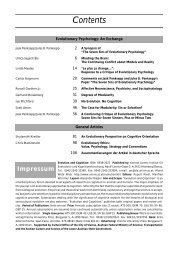Contents - Konrad Lorenz Institute
Contents - Konrad Lorenz Institute
Contents - Konrad Lorenz Institute
Create successful ePaper yourself
Turn your PDF publications into a flip-book with our unique Google optimized e-Paper software.
Michel A. Hofman<br />
ture of the world than a monkey’s brain and an infant’s<br />
brain maps less than an adult’s brain. But<br />
unlike two-dimensional road maps, the neural<br />
maps of reality will be multi-dimensional, probably<br />
very high-dimensional maps (CHURCHLAND 1996;<br />
GLYMOUR 2001).<br />
The coherence and predictive power that representational<br />
models of reality enjoy is explained by<br />
biological evolution. The better and faster the<br />
brain’s predicitve capacities relative to the organism’s<br />
modus vivendi, the better its chances of survival<br />
and reproduction. In the broadest terms, the<br />
solution found by evolution to the problem of prediction<br />
is to modify execution programs by sensory<br />
information. The value of the sensory input is<br />
greater if it can signal organism-relevant features<br />
and causal regularities between events. To achieve<br />
this, the system needs neural cell clusters that are<br />
interposed between the sensory system and the motor<br />
system to find and embody higher order regularities.<br />
According to CHURCHLAND and CHURCHLAND<br />
(2003), the richer the interposed neural resources,<br />
the more sophisticated the statistical capacities and<br />
the greater the isomorphisms achievable between<br />
the brain’s categorial/causal maps and the world’s<br />
categorial/causal structures. Higher degrees of isomorphism<br />
lead to more reliable models of the<br />
world. As we cannot directly compare representational<br />
models and the world modelled, predictive<br />
success is the measure of fidelity and the guide to<br />
the need for model revision. The reality-appearance<br />
distinction ultimately rests on comparisons between<br />
the predicitve merits of distinct representational<br />
models; the better the model’s predicitve profile<br />
the closer it is to the truth.<br />
Neural Substrates of Intelligence<br />
If we now assume that biological intelligence in<br />
higher organisms is the product of processes of<br />
complex sensory information processing and mental<br />
faculties, responsible for the planning, execution<br />
and evaluation of intelligent behavior, variations<br />
among species in intelligence must in<br />
principle be observable in the neural substrate. Before<br />
attempting to determine the underlying neural<br />
mechanisms of intelligence, we should have in<br />
mind a specific biological entity towards which to<br />
direct our attention. Conceiving biological intelligence<br />
as the capacity of an organism to construct an<br />
adequate model of reality, implies that the spectrum<br />
of inquiry may range from the sensory receptor<br />
system to behavior in its broadest sense (that is<br />
to say, overt activity as well as internal homeostatic<br />
action). Usually, however, valid comparisons at the<br />
extremes of the spectrum i.e., at the level of sense<br />
organs and complex behavior patterns, respectively,<br />
are difficult to make in view of the very great<br />
sensorimotor differences that exist among species<br />
(see, e.g., PIRLOT 1987; MACPHAIL 1993, MACPHAIL/<br />
BOLHUIS 2001; ROTH/WULLIMANN 2001). How to<br />
compare in mammals, for example, the sensory capacity<br />
of diurnal monkeys with stereoscopic vision<br />
with that of nocturnal echolocating bats, or the<br />
learning ability of terrestrial shrews with that of<br />
marine dolphins Differences in intelligence may<br />
in fact be uncorrelated with measurable differences<br />
in overt behavior, nor are such differences implicit<br />
in many learning situations, since both activities<br />
depend on the behavioral potential of the organism<br />
as well as on its internal state (attention, motivation,<br />
etc.; a starving rat, for instance, is probably<br />
not more intelligent than a satiated one!).<br />
To avoid these formal problems, one should instead<br />
investigate the ‘general-purpose’ (neo)cortical<br />
areas, where both perception and instruction take<br />
place. It is the organism’s neural substrate where<br />
the external world is interpreted and modelled,<br />
where concepts are formed and hypotheses tested,<br />
in short, where the physical world interacts with<br />
the mind. Since the primary function of the brain is<br />
to adequately interact with the external world,<br />
brain function can be most readily characterized by<br />
the manner in which the brain senses the physical<br />
environment and how it responds to it by generating<br />
motor actions. From experimental and theoretical<br />
studies it has become evident that the brain is a<br />
distributed parallel processor where most of the<br />
sensory information is analyzed in parallel involving<br />
large neuronal networks (FREEMAN 1975; BAL-<br />
LARD 1986; ZEKI/BARTELS 1999). The principle of parallel<br />
processing implies that activities of ordered<br />
sets of nerve cells can be considered to be mathematical<br />
vectors (or tensors). An important aspect of<br />
this vector approach is that it focuses on the explanation<br />
of brain function in terms of neuronal networks,<br />
and that it is therefore compatible with the<br />
modular and hierarchical organization of the brain.<br />
Despite these major developments to explain<br />
brain function in terms of tensors, the attempts<br />
have so far been confined to sensorimotor operations<br />
(PELLIONISZ 1988), whereas no current theory<br />
successfully relates higher brain functions to details<br />
of the underlying neural structure. This is hardly<br />
surprising in view of the enormous functional complexity<br />
of the brain, especially that of higher verte-<br />
Evolution and Cognition ❘ 180 ❘ 2003, Vol. 9, No. 2








